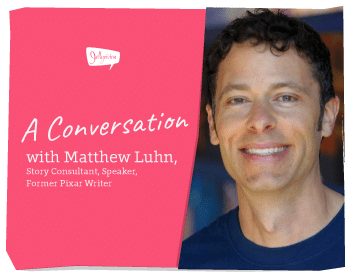Matthew Luhn is a writer, story consultant, and creative writing instructor with over 25 years’ experience creating stories and characters at Pixar Animation Studios, The Simpsons, and beyond. Luhn, author of The Best Story Wins and one of the keynote speakers at Jellyvision’s inaugural Big Ideas Summit, uses that experience to train senior leaders on how to craft and tell stories for Fortune 500 companies, Academy Award-winning movies, and corporate brands.

We had the chance to sit down with Matthew to pick his brain about the importance of thoughtful storytelling in business in general, and in benefits and financial communications in particular. Also, we geeked out about Toy Story. It couldn’t be helped.
Jellyvision:
You worked at Pixar for 20-plus years helping craft amazing movie scripts. When did you first think that what you knew about this kind of storytelling might be useful to companies trying to communicate with potential customers and their own employees?
Matthew Luhn:
I was one of those people that was watching all of Mad Men. And as I’m watching every episode, and I see Don Draper doing his pitches, you know…I couldn’t help but say to myself, “That’s exactly what I do, but I do it with pitching and selling people on the idea of animated characters and wanting to go see the Pixar films!” So that was always in the back of my head, where I was like, “Wow, marketing and sales are very similar to making a story pitch.”
Then I got asked to do a talk in Helsinki, and at first I had no idea why this group of businesspeople would want me to come out and do my talk on storytelling for filmmakers. These business people were intently taking notes as I talked about how to create great stories for film, but then when I heard the questions they were asking afterwards, I was like, “Oh, okay, I get it! This can totally work for sales and marketing and business, too.” Those were the two instances.
Jellyvision:
So what were a few of the big insights from your Pixar experience that you immediately started hitting on with these types of audiences?
Matthew Luhn:
Well, I think first off, we all know that, in business, a lot of your job is making pitches and presentations, either internally or externally. And then, also, when you’re making those pitches to people externally, to clients or customers, about what your company does—the products, the solutions, the ideas—that’s the same thing I do on a regular basis these days, whether I’m making a pitch to Netflix or Pixar or Disney. You really have to grab people’s attention within eight seconds. That’s the attention span of people. And so the pitch, the presentation, needs to be clear and concise. And the techniques I used for entertainment are the same ones that I help companies use in the business world.
Jellyvision:
That’s interesting. Most of the communications that we help our HR customers with are the employer-to-employee kind, the internal kind you were talking about. Often, these HR teams are faced with employees who feel confused and intimidated by the information they’re getting. And that confusion and lack of engagement can make it hard for them to motivate these employees to take steps that could really benefit them—like putting money in a special tax-saving fund or signing up for a different plan that seems scary at first, but is a better fit.
I’m curious what your take is on bringing storytelling to bear in this kind of context.
Matthew Luhn:
I think what you’re getting at with this is, how do you get people to adopt a new idea and try something new? And the statistic on that is that 18% of the world’s population are considered to be early adopters—people who will try something new, without needing to have any motivation. The kind of those people that you hate, because they just say, you know what, I’m going to start working out for an hour every day, or I’m going to just stop smoking today, I’m done. And the rest of the world…well, people don’t just change willy nilly like that!
For the rest of the world, what motivates them to change is to see proof. They want to see other people who’ve tried it and have had a success. Or, if that doesn’t work, the next thing is that something tragic happens in their life, and they’re forced to change. If you go to the doctor, and the doctor says “You have high blood pressure, and if you don’t start eating more of something and less of something else, you’re going to die,” that’s a wake-up call that’s more about, “Oh, crap, I need to change.”
But if you don’t want to reach that point, the best way to get people to try something new is to share with them a story, or a metaphor, or an anecdote of how somebody else missed out because they, say, weren’t smart about their 401(k). It’s always great if you use yourself as the example. Or you say, “I thought the same thing. But I did get a 401k when I was 22 years old, and now I’m going to be able to retire comfortably at this age.”
That’s the thing about stories that you’ll notice. In all the best stories—movies, TV, books, theater, all that—the main character goes through a transformation, a change, right? Where they start off one way in the beginning of the story—they may be timid, like Harry Potter—but at the end of the story, he’s brave. And the whole reason why we’ve always told stories with the main character going through a transformation is because we put ourselves in that character’s shoes, and we go, “Maybe I should be a little more brave, with certain situations in my life.”
And if you look at the first stories that we heard as kids, a lot of them were cautionary tales, where a character made a bad decision. And so, they may have started off as a good person. But they lied. They were greedy, they didn’t help somebody in need. And they had a bad end to their story, like the little boy who cried wolf, right? And he kept lying, and then he got eaten by a wolf!
The reason why we told those stories, or were told those stories, was because they would be more memorable. And we would remember the story, and then we would remember not to lie. So when somebody in HR is trying to convince somebody to contribute to a 401(k) or something, if they just go to the statistics, that is not going to be memorable or impactful, right? If they just lay out a graph of information, people are not going to remember it when the meeting is over. If they do share with them a personal experience, or something that’s happened to somebody else in the form of a short story—yeah, people are going to remember it. And it’s proven. And that’s what inspires people to try something new.
Jellyvision:
Practically speaking, this sounds like this could be HR people reaching out to employees for testimonials, people that have really liked something, or creating scenarios, where instead of saying, “Hey, employees in this category should do XYZ,” it’s like, “Imagine Tom. Tom is forty years old. He has this kind of situation going on. Here’s the story of Tom and what he did and what you should learn from it.” Approaches like that.
Matthew Luhn:
Yes, exactly. That’s why testimonials and endorsements are so important. For companies and for people. Because it makes me feel comfortable that I’m not just jumping into something that hasn’t been tried and proven.
Jellyvision:
In some of the webinars and guides we create here, we advise HR pros to try thinking like a marketer: communicate in a way that focuses on how something will bring people pleasure (or relief or whatever) or help them avoid some sort of pain or trouble. What’s your take on this kind of approach?
Matthew Luhn:
So if you go through all the stories that have ever been told, 99% of them will revolve around our fears and our desires, exactly what you were just saying. Our desires could be things like the desire for love, the desire for safety and security, the desire to live our dreams and be spontaneous, have freedom. And then we also have these fears: fears of abandonment, fears of failure. And these are universal. These aren’t just for people in one particular country, it’s for every culture, it’s for every gender, it’s for every age. These are universal themes that keep showing up again and again.
Beyond all of the special effects in a Pixar film, and the great actors and actresses—the reason why those films are so great is because they tap into a universal theme that everybody can connect to. So the movie Wall-E: the last robot on earth that wants to fall in love. Finding Nemo: the father that wants to keep his only child who is handicapped—he has a broken fin—safe and secure. And then on the fears side: Woody, wanting to be the number one toy and loved by his owner, is replaced by a cooler toy, Buzz Lightyear. He fears being abandoned, right?
So the thing is, when you create a story, you want a great hook. You want to have a character going through a transformation. The third thing you want, is you want the audience to be able to connect with the story being told. Stephen King has this great quote that says something in the way of—don’t write for yourself. You should be writing your story for somebody, right? If you just write a story for yourself, it may not connect with anybody else. You want to make sure that you’re connecting with either a broad audience, like Pixar does, or a specific audience, just one person.
So in the world of business, if you are trying to connect with a broad audience, different genders, different ages, different cultures, you want to use one of those universal themes that I talked about. If you are talking about a product, solution, an idea, you want to be able to use a metaphor. You want to be able to share a small story that connects to why this product or idea is great. And you want to make sure that there is a universal theme in there that can connect with people, so everyone gets it.
And then there’s times where you just want to connect with a specific audience, like, say, maybe it’s parents. And that’s when you’re like, “What’s important to parents?” That’s kind of a long-winded answer here that leads up to your question, which is—when you look at what’s important to parents, you can say that the thing that’s important to them is, hopefully, being a good parent! Taking care of their kids, being there for them. Their weakness, or the thing that keeps them from that goal, are the obstacles in their life: I’ve gotta work, I’ve gotta pay the bills, I’ve got to try to eat well and exercise.
I do the same thing when I’m putting together a story, whether for entertainment or business. One of the first things I ask is, “Who is this for?”
Jellyvision:
Right. Who’s the audience? It seems to me too, circling back to the world of HR and benefits, there are probably opportunities there to think about your employee population in terms of different smaller groups, right? Like, young employees versus older employees, who are more worried about retirement than maybe the younger people are—and doing segmented messaging, using the same principle.
Matthew Luhn:
Absolutely. I mean, if I was in HR, I could see doing things like reaching out all of the new employees with one message…or all the employees who haven’t done anything with their 401(k), or whatever groups are important to connect to.
But what I would also do is say, or find someone who could say, “Here’s my experience, as somebody who did get a 401(k) when I was in my 20s.” But you would want to make sure that the examples you shared with these different groups—that the character in the example is someone they can relate to. So that’s really important, because it’ll connect better with them. When I went to my son’s high school to speak, I didn’t talk about how hard it is to be a parent of three kids. That’s interesting to me, maybe, but not to them. What I did was, I talked about what it was like when I was in high school, and desires and fears I had, and how I was able to get through it. So you can use yourself as an example, as you go back to that particular age that you’re trying to connect to.
Jellyvision:
Love that. Tailor your message. Put yourself in their shoes.
Matthew Luhn:
That’s what I would do.
Jellyvision:
Matthew, just one last question, not at all HR-related. You probably get asked this all the time, but do you have a couple of favorite Pixar movies, ones that are closest to your heart?
Matthew Luhn:
Sure! Definitely, all of the Toy Story movies, and those characters. First, because I worked on all of them, and Toy Story was the first film I worked on. But also, because my family has owned toy stores for many years. So my parents, my grandparents, my great-grandparents have owned a chain of toy stores in San Francisco that are family-owned and run. I do have a love of toys that’s kind of in my DNA. So the whole idea of working on the film that is about toys…it was like, meant to be, you know? So definitely those films. And I also love those films simply because of the story and the emotion in them.
Jellyvision:
I saw Toy Story 4 this past weekend with my mom who hadn’t seen any of the Toy Story movies, and my seven-year-old son who’d seen all of them. And like a lot of people, going in, I was thinking, “How can you top Toy Story 3?” But it was fantastic – just as good as 3, I thought. The story found new depths.
(Note: Mild spoilers ahead.)
Matthew Luhn:
Yeah, you know, it’s not easy to make a sequel or a trilogy from a franchise. But I’ll tell you, one of the reasons why those films work is because you’re constantly going back to Woody’s fear of abandonment in every film, right? If you really go back and you look at every one, it’s like: I’m going to be abandoned because the cooler toys arrived. Second film, I’m getting old and falling apart, I’m going to be abandoned and thrown in the garbage. Third film, the one I love is leaving for college, and I need to allow myself to be abandoned. And the fourth one is—this is a little bit of a spoiler alert—what happens when your purpose in life has been fulfilled. You’ve done a great job, you finished that career, you’ve raised those kids. You’ve done an awesome job with what your purpose is, but now your purpose is over. Right? How do you transition to the chapter after that? That’s why I know some people will be kind of bummed out by how the movie ends. But after you let it seep in, and you think about it, you realize that that is a great transition to Woody’s next purpose in his life. It’s a very rewarding ending.
Jellyvision:
I loved it. I’d bet it hit home especially for middle-aged people and older….
Matthew Luhn:
Yeah, you’re right. When you’re me with a 20-year-old leaving for college—if I didn’t have my younger kids as well, I would be a complete wreck. And not just because of the end of Toy Story 3 kind of feeling, but because here you’re like, “Is my purpose as a father over right now?” But then you realize that there are always next chapters for everybody in life. A new purpose.
Jellyvision:
It ends with a beginning, which is kind of beautiful.
Matthew Luhn:
It does. It does. And it’s a great twist on what Woody’s next new purpose is now. I don’t know if Pixar is going to make more Toy Story movies. I’m no longer there, so I don’t know. But it’s even nice just to leave it to the audience to think about how Woody is going to live out that next stage of his life. And I think it’s great, you know?
Jellyvision:
Yeah, it was fantastic. Thanks much for indulging me that, and for sitting down to chat today.
Matthew Luhn:
My pleasure!


